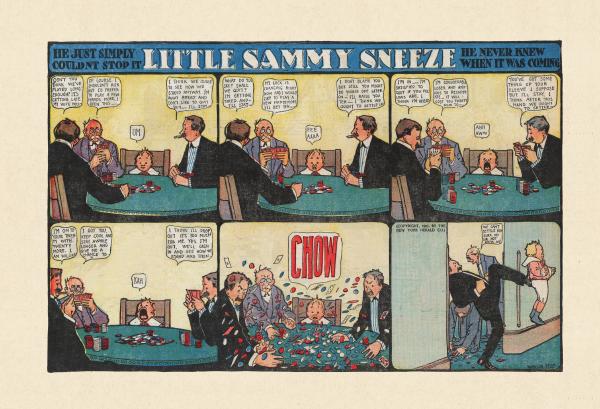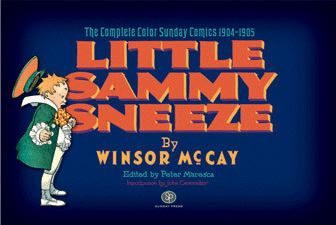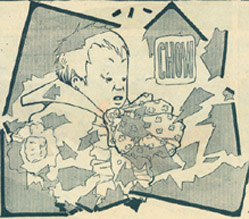
The third of the four coolest books published in the past few years is (I am compelled to report) also from Sunday Press Books — a collection of Winsor McCay’s pre-Nemo comic strip Little Sammy Sneeze.
This book is not a gigantic volume reproducing newspaper pages in full size, simply because Little Sammy did not command a full page on Sundays. It is, instead, a good-sized coffee-table book — all that’s needed to reproduce McCay’s color Sammy Sneeze strips almost exactly as they were originally published.

Sunday Press’s philosophy in regard to reproducing old color strips is
very sensible. They use modern digital techniques to correct the
fading of colors and the yellowing of paper, but don’t try to improve
on the colors as they would actually have appeared to a reader of the
time and don’t try to eliminate minor characteristic printing
errors. What one sees in their books is thus a very close
approximation of the medium the comic strip artists composed for.
In Little Sammy Sneeze, McCay took a very small idea and made something wonderful out of it. The strips normally employ either six or eight panels, all showing the same location and generally from the same point of view. Activity proceeds within the space of the location as Little Sammy works himself up to a sneeze, which usually produces catastrophic effects within the location and causes Sammy to be ejected from it angrily. For some reason, this mechanical formula produces endless delight — much the way simple variations on a musical theme can produce endless delight.
The drawing, of course, is brilliant, as you’d expect from McCay, and the period detail within the mostly realistic settings has only grown more magical with time. The strips are in part about time, of course — small segments of time in which many things happen.
Seeing the way static pictures on a page can evoke a sense of the passage of time is intrinsically fascinating. It’s like deconstructing the process of cinema, with the illusion laid out anatomically before you.
In one instance, McCay deconstructs his own medium, as Sammy’s sneeze fractures the frame of the comic strip panel itself:

If the gag in the strip is always the same, or more or less the same,
it is nevertheless always surprising — or perhaps one should say
always suspenseful. There’s a psychological phenomenon involved
here that’s at the core of any good joke, which can make you laugh even
if you’ve heard it before. In part, it’s the shape of the joke that
makes it work — a tension is created that can only be resolved with
the release of a laugh. The same phenomenon is at work in all
stories, which is why it’s possible to cry every time you read A Christmas Carol — even if you know it almost by heart.
You can obtain Sammy’s sneezes here.
